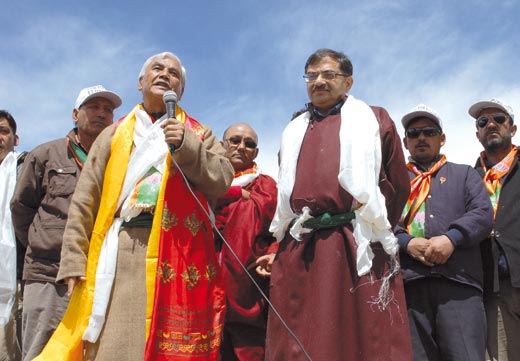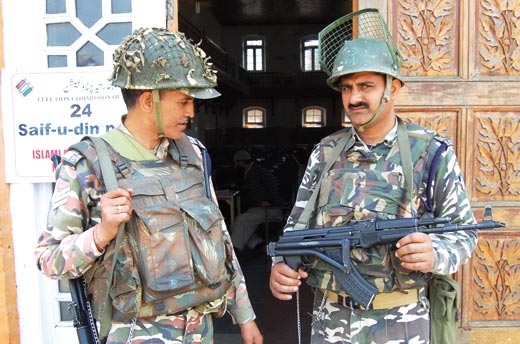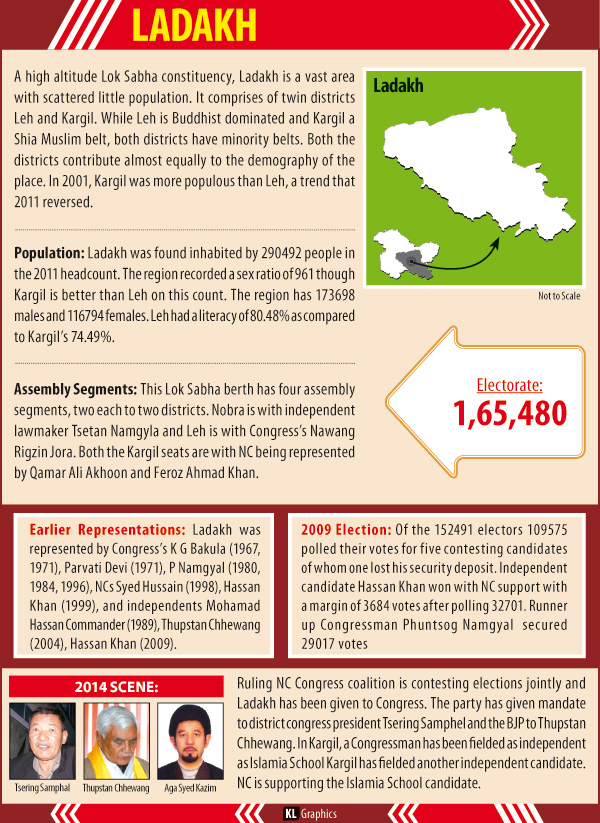High Altitude Battle
Unlike the last four phases in J&K, the last one involving Ladakh and Baramulla is being contested by parties so intensely that it has become completely unpredictable. While the heterogeneity is exhibiting on communal basis in the desert, it is showing on ethnic grounds in North Kashmir. KL exclusives from the two ends of the state
World famous Discovery Channel has selected Ladakh to shot its documentary on the elections in world’s most populous democracies. It could be a huge film because there are slightly more than 80,000 voters who would cast their votes on May 7, 2014 in 274 polling stations. But the interesting part is that these polling stations are scattered over an area of 45,000 square kms – an area bigger than Denmark, Switzerland and actually more than double the size of Israel. Ladakh is bigger than 75 countries of the world.
India’s Robin Roy Films has already sent its crew and it will shot in different directions for a week to produce the film. The idea behind the move is to understand how a country is making adequate and enough arrangements to ensure participation in polls for a small population that lives in inhospitable terrain. It will highlight, according to Roy, the efforts that Election Commission of India is making to reach every voter despite the poor accessibility.
Leh part of the constituency has five polling stations at Lingshed, Neraks, Fotoksar, Yulchurg and Squmpata with an average of 90 voters but the ECI will fly staff to ensure their participation. Besides, there are 11 stations along the China border and 20 others on along the LOAC with Pakistan border. With fascinating backgrounds and nude peaks, this offers a perfect picture for the dance of democracy in the arid desert, something people will love to watch.
But what Discovery Channel would miss is the politics of the desert. In the last few weeks, the region has become a cemetery of coalition politics as the exercise has divided the people on communal lines. Ladakh seat that comprises Kargil and Leh is not divided between the two communities – Muslims and Buddhists, inhabiting the two districts but also between the two parties that make the ruling coalition. The story is getting intense with every passing day.
Under the coalition arrangement, NC was limited to three Kashmir seats and Congress got two in Jammu and one in Ladakh. The arrangement included being together in supporting the candidacy of the people nominated by the two. Congress took a long time in identifying its candidate. There were a few from Kargil and at least two from Leh. Finally it was the district congress chief T Samphal who was approved by the Congress High Command.
That changed the situation altogether. The twin districts have exhibited a strange relationship over the mandate in Lok Sabha. With nearly equal votes, they have had the tradition of fielding an independent in case they feel deprived by a decision of a party. If a party picks a candidate from Leh, Kargil reacts and vice versa. Leh did it once and Kargil twice. In 2009, Kargil’s independent candidate Ghulam Hassan Khan (who later joined NC), defeated Congress P Namgyal, by a narrow margin of 3600 votes.
That happened in past and was repeated this time, again. Congress in Kargil is running a turf war with the NC and the Ladakh Autonomous Hill Development Council (LAHDC) in Kargil was the main battle ring. Though Congress’s Asgar Karbalie is heading the council, NC did its bit to overthrow him. That happened in anticipation of the Lok Sabha polls. As Samphal got the mandate, Karbalie managed fielding Ghulam Raza. He was district president Congress and was asked to resign and file nomination papers as independent.
NC men in Kargil landed in a crisis. Well before it could become an existential battle, they encouraged Syed Qasim Sabri to file his papers as independent.
Kargil that symbolizes war and battle after 1999 is home to all kinds of politics. But when it comes to political decision-making, it has become the prerogative of two religious institutions: the Imam Khomanie Trust and the Islamia School. Trust is a sort of neo-liberal thought that is currently dominated by Congress but the all-powerful School is controlled by the Aghas, town’s most influential clan. It has created a situation that Raza has no match to Sabri. But entire Kargil leadership of Congress is campaigning for Raza in Leh as well as Kargil. They want their pie in Muslim votes.
As the going got tough, NC forgot the coalition dharma under which it was to support Congress and joined in formally. Those who were seen framing the strategy to ensure Sabri’s win included NC’s all the top men: Omar’s adviser with cabinet minister’s rank Qamar Ali Akhoon, his Science and Technology minister Feroz Khan, besides former minister Haji Nissar Ali. They are making public speeches against the Congress’s T Samphal. Gauging the mood, NC has tacitly decided to support and party’s publicity wing is busy printing the campaign material in Srinagar!
As the party lost control over itself in Kargil, there are two of the LAHDC’s Congress councillors from Zanskar who are supporting BJP. This makes Leh a terribly different story. Entire Congress in Leh is behind Samphal but they are facing music from another Buddhist Thupstan Chhewang, who is contesting on BJP mandate.

Samphal and Chhewang are equally influential. But Buddhists rate the latter as more respected than the former. Scion of Leh’s Raja family that ruled the region for the long time, Chhewang’s wife Sarla is still considered the Queen of Ladakh. Chhewang shot into prominence when as head of the Ladakh Buddhist Association (LBA), he triggered a fierce communal agitation that eventually led to the creation of Ladakh Autonomous Hill Development Council (LAHDC) in 1995. He headed the Council till he was elected to Parliament in 2004. Then, he was contesting as a candidate of Ladakh Union Territory Front (LUTF).
Though Chhewang had tried his level best to get Narendra Modi campaign for him, he failed. A busy Modi sent Mukhtar Abbas Naqvi and has promised to fly Nitin Gadkari later. Chhewang is managing better crowds than all others, at least in Leh.
Congress had a huge miss while campaigning. It started its campaign with fighting for the Union Territory (UT) status for Ladakh. As the news flashed outside the desert, it triggered fierce reaction. While Congress chief in the state said UT is not part of the Congress manifesto, the NC reacted angrily. And then the PDP followed in criticizing the divisive politics in the desert. It forced a halt in Congress selling UT to the people.
With the party on back-foot on the most crucial issue that has the capacity of attracting Buddhists, the issue landed in the lap of Chhewang whose politics revolves round this issue. He successfully managed getting his slogan back to him and he kicked it to the streets. It was Chhewang who had raised the demand first in 1989, cashing on it. Chhewang with UT has changed the crowd patterns in Leh. BJP at lower level has thrown support in the UT idea, at least, for the time being.
Initially after the reaction, Congress started flirting with the idea of opposing Sindhu Darshan by BJP. It is festival that BJP’s Delhi government introduced in October 1997 and was later followed up by none other than L K Advani as Deputy Prime Minister. Given the resistance the idea had in the region for some time, Congress sees the festival as BJPs idea of impacting the Tibetan culture.
As nobody from the state and central Congress has found time to campaign for its candidate in Ladakh, Samphal has come back to UT status. But it remains to be seen how he exploits an issue that Congress coined in 1989 but used non-Congress faces to use it.
So the battlefield is completely divided b etween four players, within and outside the two districts and three parties. The situation is like this: Kargil is divided from Leh which is 235 kms away and the two districts think differently. Congress has ceased to exist in Kargil and NC in Leh. PDP does not exist at all. Congress is seeking votes separately to two candidates in two districts. Buddhist vote is divided between Congress and BJP.
In such a situation can Zanskar decide? This enclave of Buddhists that is part of Kargil district has 8000 votes which, if polled to a single candidate can decide the outcome. But that seems not happening because Zanskar is polling for both the two Buddhists and sparing a part of the mandate for Kargil’s Islamia School as well.
So who has an edge? Very difficult to guess because in the four, three are equally good: Chhewang, Sabri and Samphal. If polling is not based on faith and strictly on party basis nobody will stop Samphal. If it is completely communal then Sabri may get it. And if Modi uses Naqvis’ in the party, Chhewang has a good chance. In the worst case, if Sabri and Samphal take a bit of both then Modi manages the mandate. It is high altitude confusion.
Cover Plus: Baramulla Constituency Profile
https://kashmirlife.net/knotty-north-vol06-issue09/

















